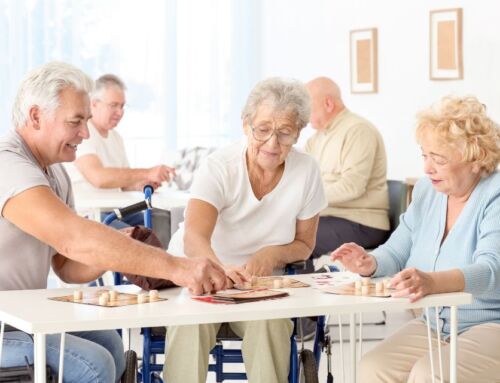Assisted Living – The Right Choice For Many Seniors
Most older adults dream of aging at home, but few understand exactly what it means. Aging at home comes with many challenges and expenses, ranging from retrofitting houses to be mobility-accessible to figuring out how to get access to affordable care as residents age and their needs change. For many seniors, assisted living provides a better alternative. Read on to find out why.
A Safe Living Environment
Ordinary residential households aren’t designed with seniors’ needs in mind. They often require substantial, expensive retrofits, especially if the home has multiple stories. Installing stairlifts, grab bars, railings, and medical alert systems can cost a small fortune, but seniors need them to maintain a safe living environment.
Assisted living facilities are designed to ensure the safety of residents. They include private, fully accessible apartments equipped with everything residents need to get around safely and avoid accidents. Plus, if a resident does experience an unavoidable fall, help will be just minutes away.
Help with Activities of Daily Living
Many seniors require help with activities of daily living (ADLs) such as maintaining personal hygiene and cooking nutritious food. There’s no shame in that, but it can place a strain on relationships for elderly residents who rely on family caregivers. Those who choose to live at home have no choice but to either rely on their loved ones or take on the financial burden of hiring home care aides, which can deplete retirement savings more quickly than some consumers might think.
Assisted living facilities keep aides on staff to help residents with ADLs. This reduces the strain on family relationships and helps aging adults maintain a sense of dignity and independence. The services provided by staff members also include tasks like housekeeping, meal preparation, and transportation, so there’s no need for residents to worry about struggling to keep up with home maintenance, housework, and other responsibilities.
Maintenance of Independence
One of the most common factors motivating some seniors’ desires to age in place at home is a desire to maintain independence. When health problems and mobility issues start to arise, that requires accepting a little help now and then. Residents at independent living facilities get their own private apartments with locked doors and all the normal amenities, allowing them to maintain their privacy, but they also receive the supportive services they need.
The ability to maintain comparative independence can also improve residents’ relationships with family members and reduce stress for everyone. Adult children, grandchildren, and other loved ones will be able to enjoy the time they spend with their aging loved ones instead of worrying about whether they are safe and happy.
Opportunities for Social Activity
When homeowners are young, they form relationships with their neighbors and integrate themselves into their local communities. As people age, those communities change. Neighbors move away, friends make their own decisions to move into assisted living facilities, and new families move in.
One unfortunate result of changing neighborhood dynamics is that elderly residents often find themselves left behind. Socialization is essential for maintaining optimal brain function and overall health, but living at home is often inherently isolating. Moving to an assisted living facility gives seniors the chance to form new relationships, interact with the staff and their peers, and participate in both structured and unstructured on-site and off-site activities. Access to transportation also makes it easier to make plans with old friends without having to drive or take public transportation.
Supervised Nutrition
Even enthusiastic home chefs often find that cooking healthy, delicious meals for one is not as satisfying, and even experienced cooks find it difficult to accommodate changing nutritional needs. At assisted living facilities, residents can expect three professionally prepared meals per day that are tailored specifically to their unique dietary needs. Access to healthy food improves residents’ health outcomes and helps them manage chronic health conditions.
Most apartments at assisted living facilities also come equipped with kitchenettes or even full kitchens. Residents who still enjoy cooking for themselves are welcome to do so in the comfort of their own homes, but most prefer to eat most of their meals in communal dining areas with their friends and neighbors. The great thing about assisted living is that both these options are always available.
Intellectual Stimulation
The best way to maintain cognitive function well into old age is to never stop learning. The managers at assisted living communities know that, so they provide plenty of opportunities for lifelong learning to interested residents. Some communities organize art classes and book clubs, while others host guest lecturers or even provide transportation to nearby cultural events.
It’s easy to fall into patterns. Those who are willing to step out of their comfort zones to learn new skills or develop different areas of expertise will benefit not just from increased knowledge but also improved cognitive function. None of these activities are mandatory, but many residents of assisted living facilities are enthusiastic about participating in lifelong learning programs.
Physical Activity
Staying in shape allows seniors to maintain more mobility and reduce their risks of developing serious, and potentially fatal, diseases like heart disease, diabetes, and even some forms of cancer. Those who exercise regularly are even statistically more likely to live longer. Most facilities are equipped with small gyms, and many schedule group exercise classes a few times a week. Access to a personal trainer and gym equipment allows all seniors to maintain a higher level of physical fitness than they could at home.
The Bottom Line
Assisted living communities are not nursing homes. Residents stay in private apartments and are allowed to come and go as they please. The focus of these facilities is to provide security, support, and the opportunity for socialization without forcing seniors to give up their independence.
For those who need more help than they are getting at home, but don’t need round-the-clock medical care, assisted living facilities offer a perfect middle ground between living alone and winding up in a nursing home. Staff will be available 24/7 to address any issues, but residents can still pursue their own passions and live independent lives. It really is the best of both worlds.


















